You can support these web-sites by donating: |
Bowls with figures from Nishapur, Kurasan, Iran, 9th-10th centuries
Saffarid-Samanid period
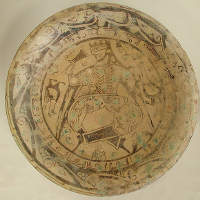
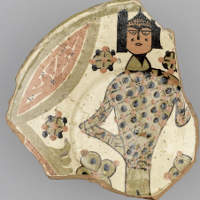
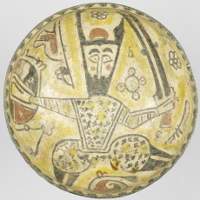
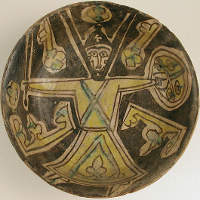
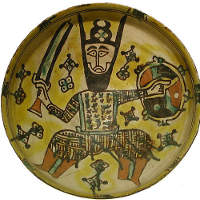
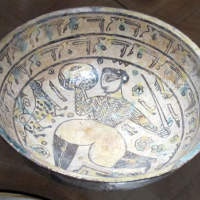
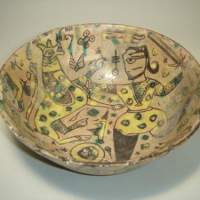
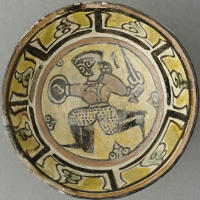
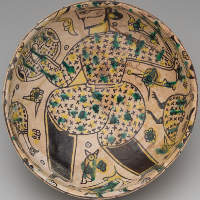
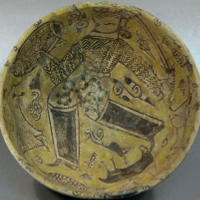
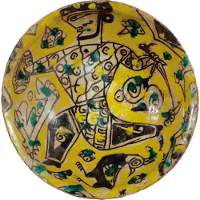
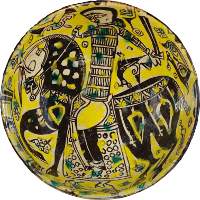
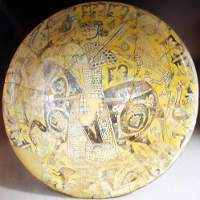
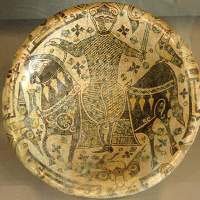
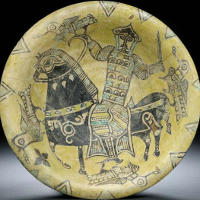
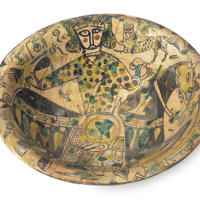
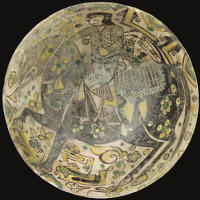
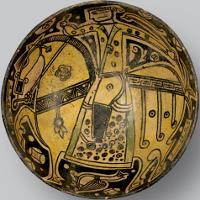
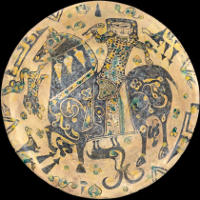
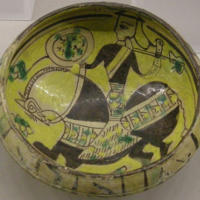
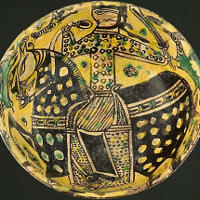
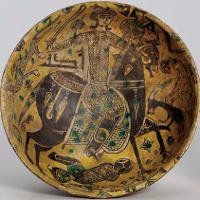
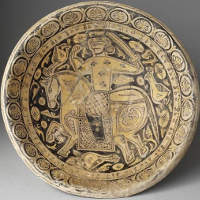
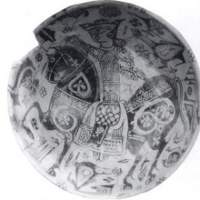
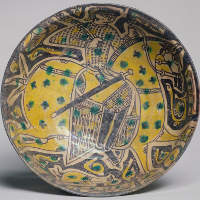
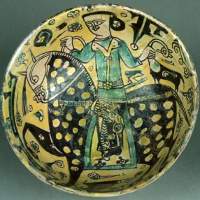
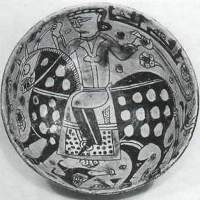
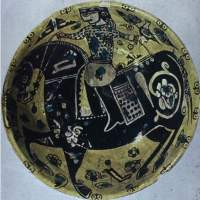
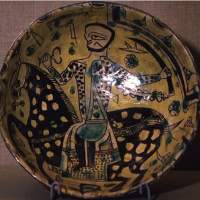
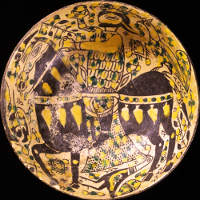
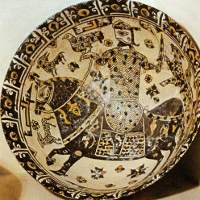
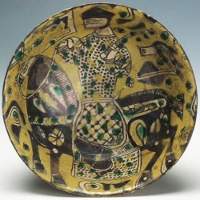
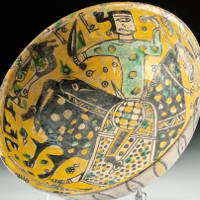
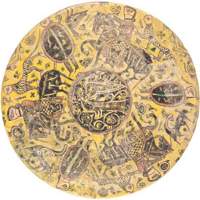
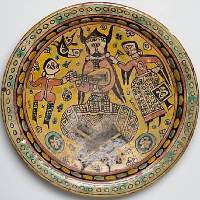
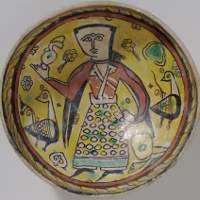
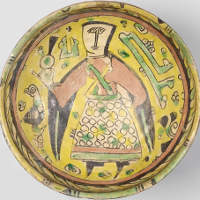
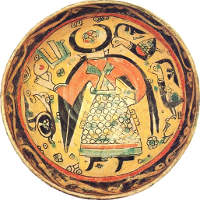
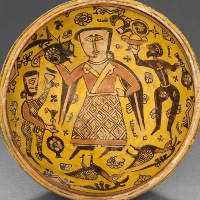
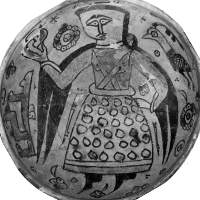
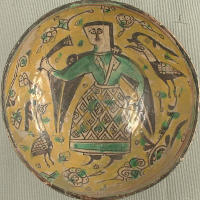
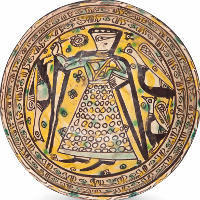
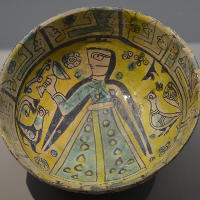
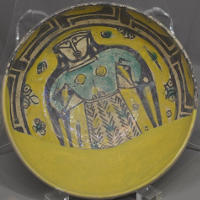
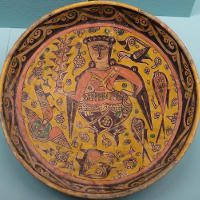
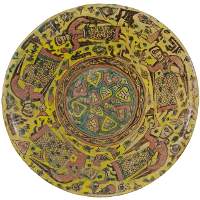
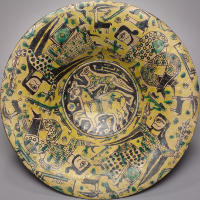
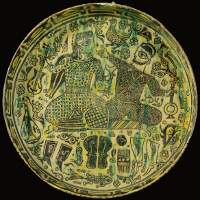
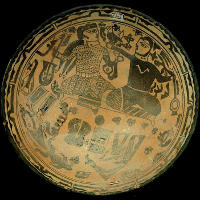
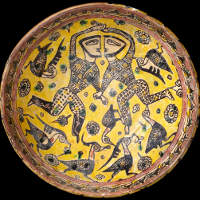
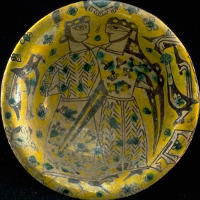
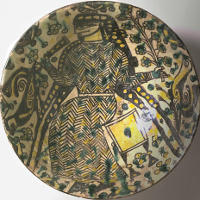
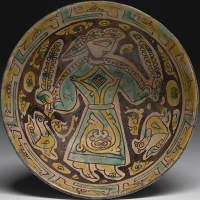
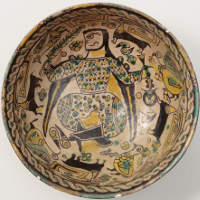
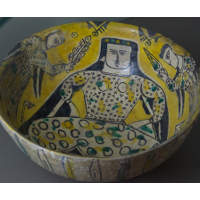
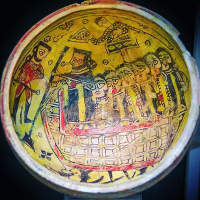
You can support these web-sites by donating: |
























































An extract from pp372-373 Vol. 2 The military technology of classical Islam by D Nicolle
Heavy cavalry of the Turkish ghulām type almost certainly played a dominant role in Sāmānid armies as shown in these sources. Horse-armour, known as barqustuwān and probably similar if not identical to the Arab tijfāf,56 frequently crops up in Firdawsī's
56. Bivar, "Cavalry Equipment and Tactics on the Euphrates Frontier," p. 291.
Shāhnāmah. 57 Sometimes it is specifically described as being made of mail,58 but elsewhere could well have been of felt and was easily severed by a sword-blow59 or pierced with an arrow.60 Such cumbersome horse-armour could also be cut loose and abandoned, thus enabling a rider to outstrip his pursuers.61
Sāmānid heavy cavalry otherwise wore zirih mail, jawahan cuirass, and a variety of other more obscure items of armour. All these may well appear in Sāmānid art, with the exception of horse-armour, for only one doubtful representation of a barqustuwān survives from the 9th or 10th centuries (Fig. 447). Otherwise the cavalry of Sāmānid Iran would all seem to have been heavy, though varied in their armours of mail, scale, lamellar and perhaps felt or quilt (Figs. 346, 347, 348, 349, 350 and 447). Even when not armoured, their equipment: belt and swords put them in the same tradition as that of ʿAbbāsid Iraq (Figs. 356 and 357). Similar weaponry and heavy armour was apparently used by some foot soldiers, if these pictures do not show dismounted cavalry (Figs. 345, 351, 355 and 448). The javelin-men mentioned by Firdawsī also appear (Fig. 354).
-------------
57. Firdawsī, op. cit., pp. 23, 296, 958 and 1146.
58. Ibid., pp. 106 and 489.
59. Ibid., pp. 427 and 819.
60. Ibid., pp. 1222-1223.
61. Firdawsī, Levy trans., op. cit., p. 362.
pp.396-397 Vol. 2
The Daylamīs were not, of course, the only professional infantry of Iran, nor were they the only such troops to earn a reputation outside their own area. The people of Khurāsān were noted foot soldiers, as well as cavalry. They too had their own long established traditions, particularly in siege warfare and above all in mining operations.49 Those Khurāsānīs who were sent westward to the Byzantine frontier seem to have been experts in siege and counter-siege, as were their descendants still living in AnṬākīyah, Ṭarsūs and other parts of the province of ʿAwāṣim in the late 10th century.50 These people also manufactured siege equipment and other weaponry.51
The best descriptions of 10th century Khurāsānī infantry are probably to be found in Firdawsī's Shāhnāmah. Most details refer to open battle rather than to sieges, however, and here such east Iranian foot soldiers are described as advancing with sipar shield and bow, supported by spear-men with normal nīzah spears. Elsewhere those with sipar shields, jawshan cuirasses and nīzah spears formed the front rank while archers and men with iron quzār short spears or javelins stood behind them. A third variation had the corps of infantry to the rear of some cavalry and crossbowmen. In this case they were themselves led by men with nīzah spears and shields from Gīlan, while archers with
49. Cahen, "Djaysh," loc. cit.; C. Cahen, "Ḥiṣār," Encyclopedia of Islam, second edition, vol.. III, pp. 469-470.
50. Canard, "Quelques observations sur l'introduction géographique de la Bughyat at'-T'alab," pp. 46-47.
51. Ibid.
similar sipar shields supported them.52 Some such troops appear on Iranian ceramics from the 9th to 11th centuries. These show a variety of warriors, standard bearers, javelin-men with large shields, and armoured troops with sword and buckler (Figs. 343, 351, 354 and 448).
52. Firdawsī, op. cit., pp. 1022, 1156 and 1280.
Text links to the bowls:
Bowl with a Drinker, 8th-9th Century, Nishapur, Iran, Metropolitan Museum of Art, New York
Warrior wearing a pointed helmet and a studded shirt, east Persia or Transoxiana, 10th Century, Bonhams
Bowl with a Man Holding a Sword and Shield, 10th Century, Nishapur, Iran, Bonhams
Bowl with a Man Holding a Sword and Shield, 10th Century, Nishapur, Iran or Samarqand, Uzbekistan, Metropolitan Museum of Art, New York
Bowl with a Man Holding a Sword and Shield, 10th Century, Nishapur, Iran, Metropolitan Museum Of Art, New York
Bowl with an armed figure, 10th Century, Nishapur, Eastern Persia, Sothebys, Ex Harvey B. Plotnick Collection
Bowl with a figure on horseback, 10th Century, Nishapur, Eastern Persia, Sothebys, Ex Harvey B. Plotnick Collection
Bowl with warrior with sword, 10th Century, Nishapur, Iran, Museo Nazionale d'Arte Orientale, Rome, Italy
Bowl with a swordsman fighting a quadruped, 9th-10th Century, Nishapur, Iran
Bowl with a warrior, 10th century, Nishapur, Eastern Persia.
Bowl with Warrior, Nishapur or Samarkand, 10th Century. Anavian Gallery, 5406.
Bowl with a Warrior with Sword and Shield, 10th Century, Nishapur, Iran. Detroit Institute of Art 1990.297.
Bowl with horseman with Leopard, 9th Century, Nishapur, Iran, National Museum of Iran, Tehran
Bowl with depiction of a cavalryman, birds and Kufic script, 9th-10th Century, Nishapur, Iran, Museum of Islamic Art, Berlin
Bowl with horseman, 9th-10th century, Nishapur, Eastern Persia. Royal Ontario Museum, Canada, 993.95.1.
Bowl with a mounted king, 10th century, Nishapur, Eastern Persia. Ex Saeed Motamed Collection.
Bowl with a mounted horseman, 10th century, Nishapur, Eastern Persia. ex Saeed Motamed Collection.
Bowl with a mounted soldier, 10th century, Nishapur, Eastern Persia. Barakat Gallery, ADC.92.
Bowl with a mounted soldier, 10th century, Nishapur, Eastern Persia. Bonhams Lot 27, 2015AD.
Bowl with a mounted figure, 10th century, Nishapur, Eastern Persia. Museo d'Arte Orientale, Turin, Italy.
Bowl with a mounted soldier, 10th-11th century, Nishapur, Eastern Persia. Lalla Hadria Museum, Tunisia.
Bowl with a mounted soldier, 10th century, Nishapur, Eastern Persia. Christes Lot 203, 2002AD.
Bowl with a figure on horseback, 10th-11th century, Nishapur, Eastern Persia. Louvre, Paris, MAO 402.
Bowl with depiction of a cavalryman, 9th-10th Century, Nishapur, Iran, Museum of Islamic Arts, Sharjah, UAE
Bowl with horseman, 10th Century, Nishapur, Iran, Victoria and Albert Museum
Bowl with horseman, 10th Century, Nishapur, Iran, Denver Art Museum
Bowl with horseman, 9th-10th Century, Nishapur, Iran, Museum für Kunst und Gewerbe, Hamburg
Bowl with falconer, 9th-10th Century, Nishapur, Iran
Bowl with rider, 9th-10th Century, Nishapur, Iran
Bowl with rider, Nishapur, 10th Century, David Collection Museum, Copenhagen
Bowl with horseman, 10th Century, Nishapur, Iran, Furughi Collection, Tehran
Bowl with depiction of a cavalryman, 10th Century, Asian Art Museum of San Francisco
Bowl with a mounted hunter, 9th-10th century, Nishapur, Eastern Persia. Christies Lot 234, 2000AD.
Nishapur Plate with Cavalry & Infantry, Museo Nazionale d'Arte Orientale 'Giuseppe Tucci'
Bowl with depiction of an armoured? musician, 10th Century, Nishapur, Iran, The Nelson Atkins Museum of Art, Kansas City
Bowl with standing figure in coat with lapels, 10th Century, Nishapur, Iran, Harvard Art Museums
Bowl with standing figure in coat with lapels, 9th/ 10th Century, Samanid Nishapur, Iran. Bonhams, London, Lot 128 - 25 Oct 2007.
Bowl with a man with crescent horns in place of a head, c.10th Century, Samanid Nishapur, Iran. Anavian Gallery 5320.
Bowl with figure in coat with lapels; and drinkers, 10th Century, Nishapur, Iran. Museum of Islamic Art, Doha, Qatar.
Bowl with standing figure in coat with lapels, 10th Century, Nishapur, Iran, British Museum
Bowl with figure with goblet, 10th century, Nishapur, Eastern Persia. Metropolitan Museum of Art, New York, 38.40.290.
Bowl with figure with peacocks, 10th century, Nishapur, Eastern Persia. ex-Motamed Collection, Christies.
Bowl with a drinking figure, c.10th century, Nishapur, Eastern Persia. National Museum of Iran.
Bowl with a standing figure, c.10th century, Nishapur, Eastern Persia. National Museum of Iran.
Bowl with a seated figure, 9th-10th century, Nishapur, Eastern Persia. Linden Museum, Stuttgart, Germany, DSC03869.
Bowl with Five Figures, 10th Century, Nishapur, Iran, Sothebys
Bowl with Four Human Figures around a Horse and Cheetah, 10th Century, Nishapur, Iran. Cleveland Museum of Art, 1959.249.
Bowl with Musicians Drinking, 10th Century, Nishapur, Iran, Sothebys
Bowl with Musicians Drinking, Nishapur, Iran
Bowl with two wrestlers, Nishapur, 10th Century, David Collection Museum, Copenhagen
Bowl with two embracing figures, 10th-11th century, Nishapur, Eastern Persia. Louvre, Paris, MAO 859.
Bowl with a seated figure, 10th century, Nishapur, Eastern Persia. Los Angeles County Museum of Art, M.73.5.203.
Bowl with figure and birds, 10th century, Nishapur, Eastern Persia. ex-Xavier Guerrand-Hermès Collection.
Bowl with Seated Figure, 10th Century, Samanid Nishapur, Persia. Khalili Collection POT 389.
Bowl with seated figure, 10th Century, Samanid Nishapur, Persia. Glass and Ceramics Museum, Tehran, Iran.
Bowl with Ship, Nishapur, 10th Century. Reza Abbasi Museum, Tehran, Iran.
Four locks of very long hair may have become a theme, see an Abbasid Lustre Bowl with figure holding a Pomegranate, Mesopotamia or Central Asia, 9th Century
See also a mounted hunter on a fresco fragment from Sabz Pūshān, 10th century AD, Kurāsānī
Gabri-ware jug showing a foot soldier with a war-axe, Iranian, 9th-10th centuries. Louvre 7242
Bowl with a winged rider on horseback, 11th-12th century, Nishapur, Eastern Persia. Louvre, Paris.
Other 10th Century Illustrations of Costume & Soldiers
Other Persian Illustrations of Costume & Soldiers